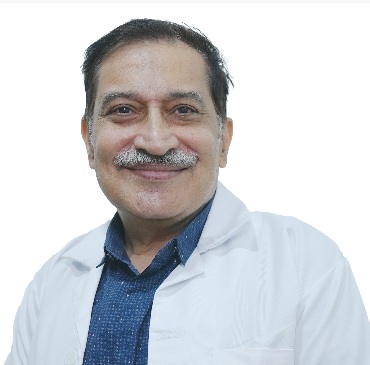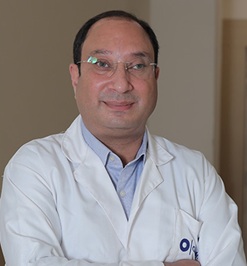Shoulder Hemiarthroplasty - Procedure, Benefits, Recovery

Treatment Duration
1 Hours
------ To ------2 Hours
Treatment Cost
₹ 3,00,000
------ To ------₹ 5,00,000

Table of Contents
- Anatomy and Physiology of Humerus
- Conditions Treated with Shoulder Hemiarthroplasty
- Who needs Shoulder Hemiarthroplasty??
- How is Shoulder Hemiarthroplasty performed?
- What Can You Expect Before the Surgery?
- What Can You Expect After the Surgery?
- Benefits of Shoulder Hemiarthroplasty
- What are the risks amd complications of Shoulder Hemiarthroplasty?
- Cost of Shoulder Hemiarthroplasty
The humerus can become severely damaged due to an acute injury or chronic disease, causing pain and discomfort. A shoulder hemiarthroplasty is a procedure to treat the shoulder joint, relieving pain and improving mobility. In partial shoulder replacement surgery, the damaged humeral head (the rounded end of the humerus) is replaced with a prosthetic (artificial) humeral head.
| Procedure Name | Shoulder Hemiarthroplasty |
| Alternative Name | Partial Shoulder Replacement |
| Conditions Treated | Glenohumeral Arthritis, Primary Arthritis, Avascular Necrosis, Capsulorrhaphy Arthropathy |
| Benefits of Procedure | Less complications, Relieves pain, Less Recovery Time, and Less Risk of joint component. |
| Treated By | Orthopaedic Surgeon |
You can check Shoulder Hemiarthroplasty Cost here.
Anatomy and Physiology of Humerus
- Proximal: The upper part of the humerus closest to the shoulder, which includes:
- A head (rounded part of the humerus)
- Tubercles (the bony area that serves as attachment points for the shoulder joint muscles)
- Surgical neck (the base of the proximal humerus)
- Body or Shaft: The long middle portion of the humerus
- Distal: The lower part of the humerus closest to the elbow. It includes:-
- Epicondyles (bony protrusions that serve as attachment points for the lower arm, wrist, and hand muscles)
- Trochlea (interacts with the ulna bone in your lower arm)
- Capitulum (interacts with the radius bone of your lower arm)
- Fossae (a depression or hollow that accommodates the lower arm bones when the elbow joint is moved)
Shoulder arthroplasty is a total shoulder replacement surgery in which the humeral head and glenoid are replaced with a metal ball and plastic socket, respectively. Whereas shoulder hemiarthroplasty is a partial shoulder replacement surgery in which only the humeral head is replaced with a prosthesis, and the glenoid is left undisturbed.
What is Prosthesis?
A prosthesis is an artificial implant to replace a missing or damaged body part. For a shoulder hemiarthroplasty, the prosthesis does not have a glenoid component. It consists of a stemmed metal humeral component and a customisable head neck and stem parts.
Expert Doctors (10)
NABH Accredited Hospitals (10)


Conditions Treated with Shoulder Hemiarthroplasty
- Glenohumeral Arthritis: Also known as shoulder arthritis, it is a degenerative joint disease of the shoulder which includes damage to the articular surfaces of the humeral head or glenoid
- Primary Arthritis: Caused by the breakdown of cartilage that eases friction in the joint. You may need a shoulder hemiarthroplasty when there is:
- A deficiency in rotator cuff functions
- Inadequate glenoid bone stock
- High risk of glenoid loosening in active labourers and young patients
- Avascular Necrosis: Joint degeneration caused by decreased blood flow
- Capsulorrhaphy Arthropathy: A type of arthritis that is a long-term sequela, i.e., a complication caused by previous shoulder dislocation surgery
- Rotator Cuff Tear Arthropathy: Occurs due to a rip in the rotator cuff’s tendon
- Chondrolysis: Destruction of the cartilage
- Proximal Humeral Fractures: One or multiple humeral head fractures due to an injury. These fractures include:
- Poor bone quality fractures
- Head-splitting fractures (a part of the head of the humerus dislocates and the other unfractured part remains attached to the shaft)
- Articular fractures (when a bone breaks inside or around a joint and causes significant destruction to the articular surface)
- Tumour: A tumour that causes damage to the humeral head, not harming other joint structures
Who needs Shoulder Hemiarthroplasty??
- Patients suffering from shoulder osteoarthritis
- Patients who have suffered a shoulder fracture
- Patients who have Glenohumeral Arthritis or Primary Arthritis
- Patients suffering from Capsulorrhaphy arthropathy or Rotator cuff tear arthropathy
- Neuropathic shoulder (decreased sensory stimulation due to nerve damage in the shoulder)
- Ankylosed shoulder (restriction or stiffness of joint due to abnormal bone fusion)
- Previous glenohumeral arthrodesis (an abnormal fusion of the glenoid and the head of the humerus)
- Fractures that can be treated with open reduction and internal fixation surgery
- Poor general health
How is Shoulder Hemiarthroplasty performed?
- Step 1: Making an Incision and Accessing the Bone
The surgeon will make a five to seven inches long incision at the front of your shoulder. They will gently move the nerves and blood vessels out of the way and cut some muscles and connective tissues to access your bone. - Step 2: Removing the Damaged Bone and Replacing it With a Prosthetic Head
Your surgeon will remove the humerus’s damaged head and the surrounding degenerated cartilage on the humerus head. Next, the surgeon will fit the stem of the prosthesis in the long portion of your humerus. Sometimes, he/she may have to widen the inside opening of the humerus to fit the stem. - Step 3: Holding the Prosthesis in Place
Once the surgeon puts the prosthesis in place, they will insert a particular type of cement to hold it in place. Furthermore, he/she will position the remaining structures of your joint to fit the prosthetic humeral head properly. - Step 4: Connecting the Muscles and Tissues and Closing the Wound
The surgeon will repair the muscles and connective tissues and move the nerves and blood vessels to their normal position. Next, he/she will close your skin with sutures and apply a sterile bandage to the wound.
- Stemmed Hemiarthroplasty: The surgeon replaces the humeral head with a metal ball and stem similar to that used in total shoulder replacement. The procedure is recommended when the head of your humerus is severely fractured, but the socket is normal. It is also suggested when there is a large rotator cuff tear.
- Resurfacing Hemiarthroplasty: The surgeon replaces the humeral head with a cap-like prosthesis and no stem. The procedure helps preserve bone and prevent the risk of component loosening.
What Can You Expect Before the Surgery?
- You will meet an anaesthesiologist for a pre-anaesthetic checkup.
- Your doctor will evaluate your medical history and conduct pre-operative tests, such as an X-ray, ultrasound, CT scan, and MRI.
- They will conduct a CT scan to select the size of your prosthesis.
- They will ask you about your medications, including supplements and vitamins.
- Next, they will briefly explain the procedure, hospital stay, estimated cost, and insurance formalities.
- They will also inform you about the prosthesis.
- The doctor may ask you to stop taking certain medications, such as blood thinners and anti-inflammatory drugs, several days before the procedure.
- You will have to stop eating or drinking anything after midnight the night before the procedure.
What Can You Expect on the Day of the Surgery?
- Your healthcare provider will ask you to sign consent formalities, giving your permission for the surgery.
- The team will ask you to change into a hospital gown and remove all jewellery pieces.
- Someone from the nursing staff will shave off the excess hair at the surgical site.
- The doctor will record your last meal and give you medicine with a sip of water.
- They will examine your shoulder to check if there have been any changes since the last appointment.
- You may also have an X-ray and CT scan on the day of the surgery.
- The anaesthesiologist will monitor your vital signs, such as heart rate, breathing, and blood pressure.
- The team will shift you to the OT room.
What Can You Expect During the Surgery?
- In the OT room, you will be made to relax on the operating table in either a modified beach-chair position or a semi Fowel position with your knees flexed.
- The anaesthesiologist will start an intravenous (IV) line in the opposite hand or arm to the surgical shoulder.
- Based on your PAC results, he/she will either administer general anaesthesia to put you to sleep or local anaesthesia to prevent pain.
- If you are given general anaesthesia, the anaesthesiologist will place a tube in your throat to help you breathe during the surgery.
- The nursing team will clean the surgical site with an antiseptic solution and cover your body with a drape, exposing the shoulder.
- The anaesthesiologist will monitor your vitals throughout the procedure.
- The surgeon will make an incision in your shoulder, remove the damaged bone, and replace it with a prosthesis.
- Once the prosthesis is placed in its position, he/she will repair the surrounding structures and close the skin with sutures.
- Finally, they will place a sterile bandage on the wound.
- Usually, the complete surgery takes 1-2 hours.
What Can You Expect After the Surgery?
In the hospital
- The team will move you to a recovery room to monitor your vitals and the effect of anaesthesia.
- You will receive pain medications to manage pain after the surgery.
- Once your vitals stabilise and the effect of anaesthesia wears off, the team will move you to a general ward or hospital room.
- You may either go home the same day or might have to stay overnight at the hospital.
- Before discharge, your doctor will examine your shoulder and provide home care and follow-up instructions.
At Home
- Wound Care
- Keep your incision clean and dry at all times.
- Do not shower until your surgeon approves.
- Do not soak the incision in a bath, tub, or pool for four weeks.
- You may change the dressing to your incision three days after the surgery.
- Your doctor will prescribe narcotic pain medications such as Tylenol or Oxycodone.
- You may also need to take stool softeners to prevent constipation.
- You need to wear a sling for 4-6 weeks as instructed by your doctor.
- Exercise 3-4 times every day.
- After exercising, you may apply ice to the shoulder.
- While sleeping on your back, you should place a pillow behind your elbow.
- While sleeping on your side, you should place a pillow between your arms.
- Lifting heavy objects
- Engaging in excessive shoulder motion behind the back
- Stretching or sudden movements
- Supporting body weight by hand
- Using your arm to push down while getting in and out of bed and chair
- Driving until six weeks after the surgery
After the surgery, you will meet with a physical therapist for a rehabilitation program. The therapy will initially focus on reducing symptoms and commencing movement. Gradually, it will include regaining strength and range of motion.
- Phase 1 (Weeks 1-3)
- Minimising post-surgical complications
- Reducing acute symptoms
- Initiation of movement
- Pain management
- Wound management
- Sling use
- Scapula stabilising
- Isometric strengthening (contracting the muscle without moving)
- Strengthening exercises to prevent stiffness of elbow, wrist, and hand
- Phase 2 (Weeks 4-6)
- You will no longer need the sling. The treatments include:
- Active range of movement
- Strengthening
- Stretching
- Scapula stabilising
- Scar management
- Soft tissue massage
- PNF techniques (involves stretching and contracting the muscles)
- Closed chain exercises (when the hand does not move, remaining in constant contact with the ground)
- Phase 3 (Weeks 7-12)
- Full range of motion
- Increasing muscle strength and endurance
- Soft tissue massage
- Stretching
- Closed and open-chain exercises
- Phase 4 (Weeks 12 and more)
- Full range of movement
- Advanced strengthening
- Functional training
- Advanced proprioceptive exercises
First Follow-Up Appointment
The first follow-up appointment will occur 10-14 days after the shoulder hemiarthroplasty surgery.During the visit, the doctor will remove the sutures, examine your shoulder, and look for any postoperative complications.
They will also provide further follow-up instructions.
Benefits of Shoulder Hemiarthroplasty
- Reduces the complications of post-operative wounds
- Less risk of joint component failure as compared with total shoulder arthroplasty
- Relieves symptoms such as pain, swelling, stiffness, and instability
- Improves range of motion of the shoulder joint.
- Effective if the humeral head is badly degenerated, fractured, or damaged, while the glenoid fossa (the shoulder joint’s socket) is in a reasonable good condition
- Offers complete recovery within six months
What are the risks amd complications of Shoulder Hemiarthroplasty?
- Infection
- Reaction to anaesthesia
- Bleeding
- Scarring
- Nerve damage
- Joint stiffness
- Bone fracture
- Decreased mobility due to an injury in the joint structures
- Prosthetic implant loosening
- Component malposition
When to Consult a Doctor?
Call your healthcare provider if you experience the following symptoms:- Fever
- Increasing pain around the shoulder
- Numbness or tingling in your hand or arm
- Drainage from incision site lasting more than five days
- Swelling of the arm
- Redness or warmth near the surgical site
- Nausea
- Shortness of breath or chest pain
Cost of Shoulder Hemiarthroplasty
- Type of surgery
- Age of the patient
- The medical condition of the patient
- The type of hospital facility availed - individual room or shared.
| Procedure Name | Cost Value |
| Shoulder Hemiarthroplasty | ₹3,00,000 to ₹5,00,000 |
Last Updated on: 6 November 2023
Author
HexaHealth Care Team
HexaHealth Care Team brings you medical content covering many important conditions, procedures falling under different medical specialities. The content published is thoroughly reviewed by our panel of qualified doctors for its accuracy and relevance.






















